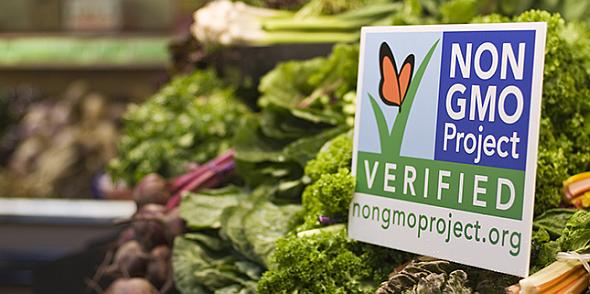Study: Consumers Confused by Food Label Language
When it comes to effectively marketing food to today’s label-conscious public, the challenge might be greater than what it appears. According to a new study, consumers are confused between foods labeled as “organic” and “non-genetically modified.” As part of the study, researchers found some consumers view the two labels as meaning the same.

Photo courtesy of the Non-GMO Project
Companies can label genetically modified (GM) foods by adding words like: “contains genetically modified ingredients” in plain text on the packages, explained Brandon McFadden, a UF/IFAS Assistant Professor of food and resource economics and lead author of the study, which is published in the journal Applied Economics: Perspectives and Policy.
McFadden and Purdue University Agricultural Economics Professor Jayson Lusk conducted their research to find the best ways to communicate whether a food has GM ingredients.
To gauge consumers’ willingness to pay for food labeled as GM vs. non-GM, researchers conducted a national survey of 1,132 respondents. Specifically, researchers wanted to know how much consumers were willing to spend on food labeled as “USDA Organic” vs. that labeled “Non-GMO Project Verified.” Genetically modified material is not allowed in food labeled “USDA Organic,” while “Non-GMO Project” means the food has no more than 0.9% GM characteristics, according to the study.
When consumers looked at packages of granola bars labeled “non-GMO Project,” they were willing to spend 35 cents more than for the boxes that had text that read, “contains genetically engineered ingredients.” With the “USDA Organic” label, consumers were willing to pay 9 cents more.
When it came to apples, respondents were willing to pay 35 cents more for those labeled “non-GMO Project” and 40 cents more for those labeled “USDA Organic.”
Participants’ responses led McFadden to conclude consumers don’t distinguish definitions of the two food labels.
In addition to a willingness to pay for GM- and non-GM foods, researchers wanted to know how QR (quick response) codes impact choices for foods labeled as containing GM ingredients. When Congress approved the National Bioengineered Food Disclosure Standard in June 2016, lawmakers allowed companies two years (until June 2018) to label their GM food by text, symbol, or an electronic digital link such as a QR code.
Study results showed consumers are willing to pay more for GM food if the information is provided by a QR code. “This finding indicates that many of the study respondents did not scan the QR code,” McFadden said.
If all respondents scanned the QR code, there would not be a significant difference in their willingness to pay, McFadden concluded. Since there is a significant difference, one can assume many respondents did not scan the QR code. “It is important to remember that this study is really a snapshot, and it is possible that over time, consumers will become more familiar with QR codes and be more likely to scan them,” he said.









